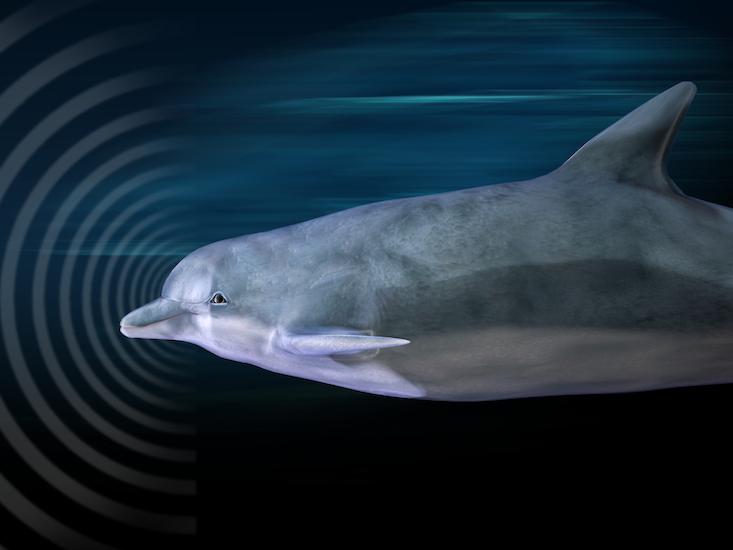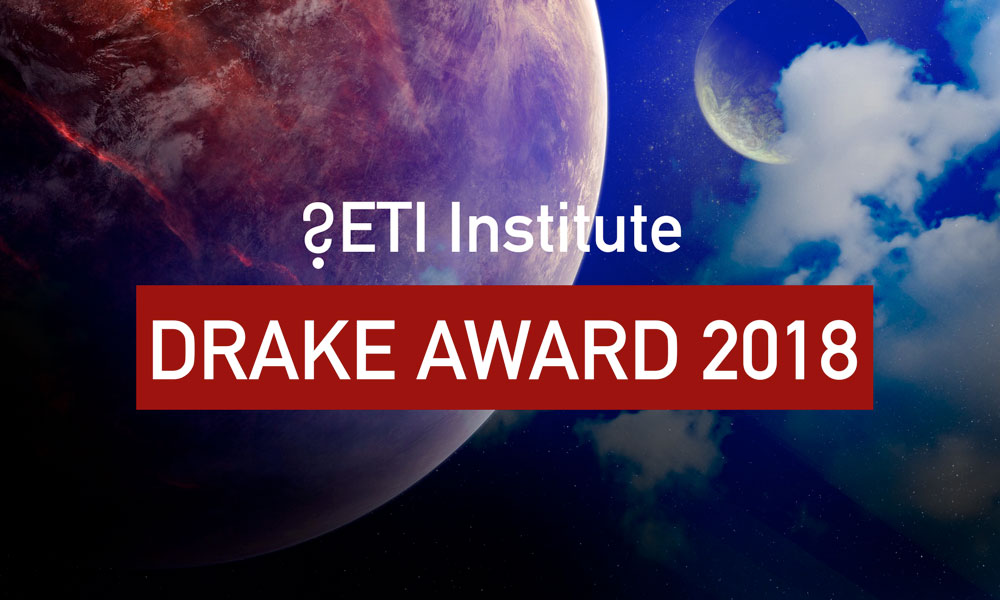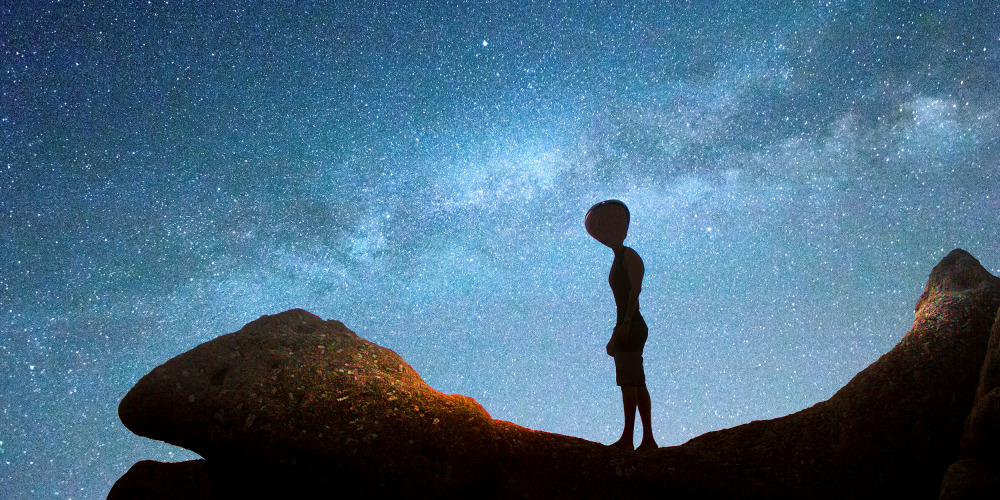
SETI research has persevered despite financial constraints, often depending solely on private sources to fund scientific research and operations. That may change in the near future, as congressional lawmakers are proposing legislation to use federal funds on the “search for technosignatures” for the first time in 25 years. Why the sudden turn? For one, our knowledge of the cosmos has changed significantly in recent decades. We no longer have only the planets in our own solar system to consider, as Seth Shostak, the SETI Institute’s Senior Astronomer, told the Atlantic:
“Kepler showed us that planets are as common as cheap motels, so that was a step along the road to finding other life because at least there’s the real estate,” says Shostak. “That doesn’t mean there’s any life there, but at least there are planets.”
As Jill Tarter, Chair Emeritus for SETI at the SETI Institute, has pointed out, we’ve only been looking at a tiny portion of the universe, and only for a short time:
“So far we’ve examined in detail one glass of water out of the ocean,” Tarter said. “If your question was, ‘Are there fish in the ocean?’, and you scooped up a glass and you looked in it and you didn’t find a fish ... I don’t think you’d conclude that there are no fish in the ocean.”
Tarter remains steadfast in her support for the SETI Institute’s mission and will continue to advocate for long-term investment in its important work.
“Ten million at once for one year won’t do much,” Tarter said. “But $10 million a year, as an ongoing funding stream, could do a great deal. It could allow people to build special-purpose instrumentation, and then use it on the sky for a long time.”
- The Atlantic: Congress Is Quietly Nudging NASA to Look for Aliens
- Tech Times: Jill Tarter Says Congress Wants To Give NASA $10 Million To Search For Aliens
 What Intelligent Animals Can Teach Us About Alien Intelligence
What Intelligent Animals Can Teach Us About Alien IntelligenceIn the early days of SETI research a group of scientists met to discuss the search for extraterrestrial intelligence. Attendees included famed astronomer Carl Sagan and SETI pioneer, Frank Drake. Drake, who is now Chair Emeritus of the SETI Institute Board of Trustees, created the well-known Drake Equation (a probabilistic argument estimating the number of communicating extraterrestrial civilizations in the Milky Way galaxy) in preparation for that meeting. But it wasn’t just signal detection that intrigued the group, but language; specifically, inter-species language. The rationale was simple: if we cannot communicate with creatures that developed on the same planet as ourselves, how can we hope to understand a signal from a distant world? To that end, an interest in dolphin communication was born, and to this day is a rich area of study thanks to technological advancements and novel applications for information theory. The work of Laurance Doyle, Senior Research Scientist at the SETI Institute, was recently profiled by Nautilus. Using a linguistic model known as Zipf’s law, Doyle was able to create a graph plotting recordings of dolphin calls and compare their patterns with those of human language:
If the dolphins engaged in meaningful communication with near-human complexity, the frequency of these sounds would yield a logarithmic slope of -1—just like most human languages. So, Doyle and his colleagues plotted recordings from a group of captive bottlenose dolphins that had been observed from infancy to adulthood. The resulting slope had a gradient of -.95. This suggests that “dolphinese” may exhibit syntax, says Doyle. “Why would such syntax exist? For one thing, this syntax enables the recovery of errors in the transmission, which definitely has survival value,” he says. “A human example might be the recovery of missing letters in a poorly copied manuscript by the use of spelling rules.”
… This mathematical tool could be the first step toward a SETI intelligence filter, helping astronomers determine whether intercepted cosmic noise bears linguistic hallmarks.
The ability to recognize complex communications here on Earth are an important step to ensuring that when E.T. calls, we are able to listen. You can learn more about Laurance Doyle’s work with the SETI Institute on our website, SETI.org.
- Nautilus: Dolphins Are Helping Us Hunt for Aliens
- SETI.org: Animal Communications, Information Theory, and the Search for Extraterrestrial Intelligence (SETI)
- SETI.org: Interview with Dr. Laurance Doyle – A Man of Many Firsts
 2018 Drake Award Recipient Victoria Meadows Reflects on What It Takes
2018 Drake Award Recipient Victoria Meadows Reflects on What It TakesGeekWnce Advisory Board that Victoria Meadows, astrobiologist with the University of Washington, had been named the first woman to receive the Drake Award. Named for pioneering SETI researcher and Chair Emeritus of the SETI Institute Board of Trustees, Dr. Frank Drake, the award honors distinguished contributors to the search for life beyond Earth. Meadows told GeekWire the honor isn’t hers alone:
“Astrobiology addresses questions so big, they can’t be answered by a single researcher of even a single field,” she said in a statement.
“Instead, it takes a community with a staggering breadth of expertise and techniques, and the willingness to work with and learn from each other,” she said. “It has been my very great honor to lead this spectacular team of interdisciplinary researchers, and a privilege to engage in such exciting and impactful research.”
The 2018 Drake Award will be presented to Meadows on June 14, during a public event held at SRI International in Menlo Park, California. Tickets are now available, and the public is invited to attend this opportunity to learn about the work of this accomplished contributor to the field of SETI.
- GeekWire: SETI Institute gives Drake Award to Univ. of Washington astrobiologist Vikki Meadows
- SETI.org: Scientist Seeking Signs of Extraterrestrial Life to Receive the SETI Institute’s Drake Award
- Tickets (via CommitChange.com): The 2018 Drake Award Honoring Victoria S. Meadows
 Asking the Big Questions
Asking the Big QuestionsSarah Scoles - author of Making Contact, a biography of SETI Institute co-founder and Chair Emeritus for SETI Jill Tarter – wrote a moving piece for PBS describing the hopes and dreams humanity pins to the search for extraterrestrial life. Scoles describes how even the Drake Equation, a probabilistic argument for estimating the number of advanced civilizations in the universe conceived by Frank Drake (pioneering astronomer and Chair Emeritus of the SETI Institute Board of Trustees), is itself an expression of humanity’s optimism:
… if SETI finds anything (or anyone), those aliens likely will have been around for a long time (the chances that we’d find aliens that had popped up just 50 years ago is smaller than minuscule)... And that would, SETI scientists have long said, give humans hope: In addition to knowing we’re not alone, we’d also suspect that however we’ve changed our planet, whatever marks we’ve left on it and each other, we could figure out how to continue existing. Those aliens figured out how, after all—and they’re aliens!
The poignant question that the SETI Institute strives to answer, “Are we alone?”, continues to inspire the public. PBS recently premiered a new series titled “Nova Wonders: Are We Alone?” looking at the same kind of profound questions the SETI Institute explores. Jane Teeling, who produced the show, shared her experience of exploring the SETI Institute’s work at the Allen Telescope Array with Space.com:
The film also joins scientists at the SETI Institute, where workers have radio telescopes trained on the sky listening for signals that advanced civilizations may be broadcasting in space. Capturing time-lapse footage of SETI's Allen Telescope Array was a particularly moving experience, said Teeling. Her team set up the equipment late in the afternoon to catch the telescopes as day transitioned to night. The sky was littered with stars when they returned around midnight. "It was so beautiful, even in this tiny screen, to see the sunset merge into the Milky Way, rising from the horizon," recounted Teeling.
You can find out more about the book, Making Contact, and the Allen Telescope Array on our website, SETI.org.
- PBS: Searching for Life Beyond Earth, Finding Our Dreams Instead
- SETI.org: The Biography of SETI Pioneer Jill Tarter, Making Contact: Jill Tarter and the Search for Extraterrestrial Intelligence, is Released
- Space.com: Two Nova Documentaries Will Explore Humanity's Biggest Questions About the Universe
- SETI.org: The Allen Telescope Array
 TRAPPIST-1: We’re Stoked!
TRAPPIST-1: We’re Stoked!Franck Marchis, Senior Scientist with the SETI Institute, recently posted an update on SETI.org compiling the latest studies on the TRAPPIST-1 planetary system. The red dwarf star system is 39 light years away and boasts seven orbiting Earth-sized planets. Discovered using the Transiting Planets and Planetesimals Small Telescope (TRAPPIST) in Chile, and analyzed further by the Kepler spacecraft, Marchis says he is “stoked” by the possibilities of future observations. Capeia recently re-published Marchis’s article.
In less than two decades, nearby planetary systems like TRAPPIST-1 will become our cosmic backyard, and if everything goes as planned with missions like TESS, PLATO, ARIEL, and JWST as well as the extremely large ground-based telescopes, we will soon learn the secrets of those exotic worlds which, I am convinced, will surprise us by their diversity, just as our own solar system has surprised us over the past two decades, surprises us today, and will surely continue to surprise us in the future.
- Capeia: An Update on the Potential Habitability of TRAPPIST-1: No Aliens yet, but We Have Learned a Lot
- Geek.com: TRAPPIST-1 Moonphase Watch Brings Cosmos to You
 Is Gravity Keeping E.T Down?
Is Gravity Keeping E.T Down?A new hypothesis suggests that the reason aliens haven’t flown over for a visit is actually quite simple: going into space is hard! Not only that, but many of the potentially habitable exoplanets discovered so far are deemed “super-Earths”, often twice as wide in diameter as our home planet, and therefore have stronger gravity. As described in a new paper by Michael Hippke, extraterrestrial space-farers using chemical rockets similar to our own might face difficulties overcoming twice the gravity we have. Is gravity what makes or breaks a space program, on any world? Seth Shostak, Senior Astronomer for the SETI Institute, takes on the question in an article for NBC News:
...even if stronger gravity delayed the inhabitants of these worlds from getting off their planet by 50 or 100 years, you have to ask: so what? Does that bump in the road matter more than the fact that the larger size of their planet would delay the laying of telegraph cables from one continent to another, or that long-distance transport would be slower, simply because the distances would be — well — longer?
Dr. Shostak also points out that a larger, heavier planet might actually be an advantage in the development of a space-faring species:
More gravity would mean a thicker atmosphere, which might speed the development of aviation. Greater acreage might bring a wider diversity of animals, possibly producing intelligence sooner than happened on Earth. And one could expect more abundant natural resources on an oversized world.
In any case, the questions arising from Hippke’s paper about the ways a species might develop advanced technology on a world very different from our own is bound to generate further discussion.
- NBC News: Could Space Aliens on Hefty Super-Earths Be Trapped by Their Own Gravity?
- BGR: Wild New Theory May Explain Why Some Aliens Never Leave Their Home Planet
- ArXive: Spaceflight from Super-Earths is difficult
 After We Detect Extraterrestrials, What’s Next?
After We Detect Extraterrestrials, What’s Next?Assuming aliens did make contact with our planet, what then? This question has often been the fodder of science fiction, but it bears serious consideration by the scientific community and political leaders as well. One of the first challenges is to circumvent any false alarms or hoaxes by validating the signal is genuine, as the SETI Institute’s Senior Astronomer, Seth Shostak, explained to Space.com:
The "acid test" is to make sure the signal is verified by multiple observatories, said SETI Institute senior astronomer Seth Shostak. "It would take a while to verify, and then the people who like to think about these matters say you would have a press conference and announce this to the world," he said, but he added that wouldn't work unless everyone in the project were sworn to secrecy. In this era of news leaks, he said that situation is very unlikely to hold.
Of course, this isn’t the first time the question of humanity’s reaction to alien life has been pondered (and it’s unlikely to be the last). And “first contact” with an alien life form might not involve a signal at all, but a microscope. Earlier this year Seth Shostak spoke to NBC News about the possibility of finding extraterrestrial microbes, which is likely to garner a very different reaction from the public than an H.G. Wells-style invasion would:
“Humans just don’t feel threatened by Martian microbes or their equivalents on Europa, Enceladus or other locales,” he told MACH in an email, referencing the moons of Jupiter and Saturn, respectively.
Dr. Shostak also wrote about the protocols that do exist, and their potential pitfalls, for NBC News last year. You can read more of Seth Shostak’s articles on our website, SETI.org.
- Space.com: How Would Humanity React If We Really Found Aliens?
- NBC News: Discovery of Alien Life Might Not Bring the Response You'd Expect
- SETI.org: What Happens Next If We Find Proof of Space Aliens?
- Facebook Live: What Would We Do if We Found a Signal? (April 26)
Tired of all this reading? Take a break with Discovery Canada’s Daily Planet, which did a short segment on Jill Tarter, Chair Emeritus for SETI at the SETI Institute and the inspiration for Carl Sagan’s main character in the novel and film, Contact. Or, if you’d like to settle in for a longer discourse on astronomy and astrophysics, the Silicon Valley Astronomy Lectures Series posted a recent talk presented by Dr. Michael Busch on near-Earth asteroids. Both videos can be viewed on YouTube (links are below).
Podcast enthusiasts may enjoy hearing Nathalie Cabrol discuss her work as director of the SETI Institute’s Carl Sagan Center, the search for life on Mars, and her fieldwork in the high Andes as the guest on a recent episode of the Space Show. And Seth Shostak, Senior Astronomer at the SETI Institute, weighed in on the Pentagon’s scandalous investigation into UFO’s in an episode of Skeptoid.
Did you know Seth Shostak hosts a radio show and podcast, produced right here at the SETI Institute? Check out Big Picture Science to get the wide-angle view on the latest scientific research and technological innovations.
- YouTube: Jill Tarter, Ultimate Mystery Hunter | Daily Planet
- YouTube: Rubble Piles in the Sky: The Science, Exploration, and Danger of Near-Earth Asteroids
- The Space Show: Broadcast 3110 Dr. Nathalie Cabrol
- Skeptoid: Podcast #621 - The Pentagon's UFO Hunt
 Big Picture Science
Big Picture ScienceLast week’s episode featured an encore of What Have You Got to Move, exploring how everything, from fish to atoms, approaches motion. This week, seek the virtuous in virtual reality with We Are VR.
Last week’s Facebook Live featured SETI Institute CEO Bill Diamond sharing updates with our fans about the SETI Institute’s latest activities – watch to find out about the Drake Award, our latest issue of Explorer Magazine, and more! This week we took a beind-the-scenes look at the Big Picture Science radio program with host Seth Stostak and co-host Molly Bentley.
Videos of all past Facebook Live events can be found on our Facebook page: https://www.facebook.com/SETIInstitute/
- Silicon Valley Astronomer Lecture Series: May 15, Lost Altos Hills, CA Chasing New Horizons: Inside the Epic First Mission to Pluto with Alan Stern and SETI Institute Scientific Advisory Board member David Grinspoon
- Space Tech Expo: May 22-24, Pasadena, CA Bill Diamond will participate
- SETI Talks: May 23, Menlo Park, CA Hal’s Legacy: 2001s Computer as Dream and Reality with David Stork
- Yerkes Observatory Starlight Festival: May 26, Williams Bay, WI Seth Shostak to speak
- SkeptiCal Con: June 10, Berkeley, CA Seth Shostak to speak
- The Drake Award: June 14, Menlo Park, CA Victoria S. Meadows will be presented with the SETI Institute’s Drake Award and speak about her work.
- Alien Con 2018: June 15-17, Pasadena, CA Seth Shostak to speak
- Astrobiology Australasia Conference 2018: June 25-26, Rotorua, New Zealand Seth Shostak to speak
- Spacefest IX: July 5-8, Tucson, AZ Seth Shostak will be a featured speaker
- COSPAR 2018: July 14-22, Pasadena, CA Seth Shostak to present “Red Dwarf Star Survey with the ATA”





